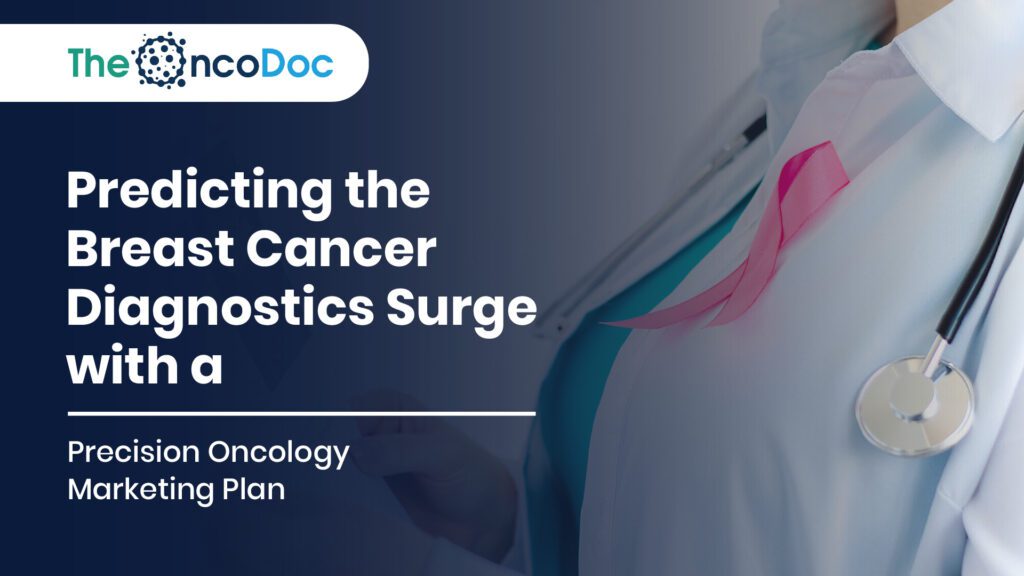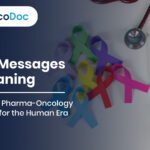Abstract
The global breast cancer diagnostics market is poised for a significant surge by 2025, driven by technological advancements, increased awareness, and rising incidence rates. This impending growth presents both immense opportunities and complex challenges for oncology marketers. This article explores the projected landscape of breast cancer diagnostics in 2025, focusing on the transformative role of AI, liquid biopsies, and 3D mammography. It delves into the implications for pharmaceutical companies and healthcare providers, outlining a strategic digital marketing framework essential for navigating this evolving environment. Emphasizing patient-centricity, data-driven insights, and ethical considerations, this piece provides actionable strategies for doctors and pharma managers to optimize their oncology marketing plans, enhance patient engagement, and drive meaningful outcomes in a competitive and rapidly advancing field.
Introduction
Breast cancer remains a formidable global health challenge, with its incidence continuing to rise. As we approach 2025, the diagnostic landscape for this disease is undergoing a profound transformation, marked by a projected surge in market size and a rapid evolution of diagnostic technologies. Reports indicate that the global breast cancer diagnostics market, valued at approximately $4.68 billion in 2024, is expected to reach $5.04 billion by 2025, with continued robust growth projected through 2035. This growth is not merely quantitative; it is qualitative, fueled by groundbreaking innovations such as artificial intelligence (AI) integration, advanced imaging techniques like 3D mammography (tomosynthesis), and the increasing adoption of non-invasive liquid biopsies.
For oncology marketing professionals, including pharmaceutical companies, diagnostic manufacturers, and healthcare providers, this surge is a clarion call. It necessitates a fundamental re-evaluation of existing marketing strategies to effectively reach, educate, and support patients, caregivers, and healthcare professionals. The traditional marketing playbook is no longer sufficient in an era where digital channels are paramount, patient journeys are increasingly complex, and ethical considerations are more critical than ever. This article will dissect the dynamics of this diagnostic surge, explore its multifaceted implications for oncology marketing, and propose a comprehensive, analytics-driven digital marketing plan designed for success in the rapidly approaching future.
The Diagnostic Landscape in 2025: A Technological Revolution
The anticipated surge in breast cancer diagnostics by 2025 is underpinned by several key drivers and technological advancements that are reshaping the field:
1. Rising Incidence and Awareness: The increasing global incidence of breast cancer, coupled with enhanced awareness campaigns and screening initiatives, is directly fueling the demand for diagnostic services. Organizations worldwide are promoting routine screenings and early detection, leading to a higher volume of diagnostic procedures.
2. Advancements in Imaging Technologies: * 3D Mammography (Digital Breast Tomosynthesis): This technology is rapidly gaining traction due to its superior ability to detect more cancers with lower recall rates compared to traditional 2D mammography. Its enhanced clarity and ability to reduce tissue overlap are critical for early and accurate diagnosis. * Ultrasound and MRI: These modalities continue to play crucial roles, often used as supplementary tools to mammography, especially for patients with dense breast tissue or those requiring further investigation. Integrated multi-modality imaging platforms are emerging, offering comprehensive diagnostic solutions.
3. The Ascendancy of AI and Machine Learning: AI is revolutionizing cancer diagnostics by significantly improving the speed, accuracy, and consistency of malignancy detection. * AI in Medical Imaging: AI algorithms are demonstrating performance comparable to, and in some studies, even exceeding expert radiologists in interpreting mammograms, reducing false negatives and false positives, and standardizing interpretations. AI-powered systems can highlight suspicious regions, guiding radiologists to potential areas of concern. * Digital Pathology: AI analyzes high-resolution digital images of biopsy samples, distinguishing benign from malignant changes and classifying cancer subtypes, thereby speeding up diagnosis and reducing variability. * Decision Support Systems: AI-powered platforms integrate patient data (imaging, pathology, genomics) to suggest diagnoses and provide evidence-based recommendations, supporting clinical decision-making.
4. The Promise of Liquid Biopsies and Genomic Testing: * Liquid Biopsies: These non-invasive blood-based tests, particularly those detecting circulating tumor DNA (ctDNA) and circulating tumor cells (CTCs), are gaining significant traction. They offer a less stressful and potentially more cost-effective way to diagnose breast cancer earlier, monitor disease progression, and detect recurrence, complementing existing diagnostic devices. The blood segment for screening tests is projected to experience the fastest growth from 2025 to 2035. * Genomic Testing (e.g., BRCA1/BRCA2, Oncotype DX, MammaPrint): These tests provide personalized insights for treatment decisions, particularly regarding the necessity of chemotherapy, and are crucial for identifying hereditary predispositions.
5. Telemedicine and Remote Diagnostics: The expansion of telemedicine networks is improving access to diagnostic services, especially in underserved areas. Digital pathology solutions enable remote interpretation of results, increasing diagnostic capacity and reducing turnaround times.
This technological convergence means that the patient journey, from initial symptom awareness to definitive diagnosis, is becoming increasingly digital and data-rich. For marketing, this implies a need to engage across diverse digital touchpoints with highly targeted and informative content.
Impact on the Oncology Marketing Ecosystem
The surge in breast cancer diagnostics fundamentally alters the marketing landscape for all stakeholders:
For Pharmaceutical Companies:
- Companion Diagnostics: The rise of personalized medicine and targeted therapies means an increased focus on companion diagnostics. Marketing efforts must seamlessly integrate the therapeutic product with its associated diagnostic test, educating both prescribers and patients on their combined value.
- Data-Driven Targeting: With more sophisticated diagnostic data available, pharma companies can refine their targeting strategies, identifying specific patient populations and healthcare professional segments that would benefit most from their diagnostic or therapeutic solutions.
- Educational Content: The complexity of new diagnostics necessitates clear, concise, and accessible educational content for healthcare professionals to ensure proper utilization and interpretation, and for patients to understand their diagnosis and treatment options.
For Diagnostic Manufacturers:
- Product Differentiation: In a crowded market, manufacturers must clearly articulate the unique advantages of their diagnostic technologies—be it superior accuracy, faster turnaround times, non-invasiveness, or cost-effectiveness.
- HCP Education and Training: Extensive marketing efforts will be required to educate oncologists, radiologists, pathologists, and primary care physicians on the clinical utility, workflow integration, and interpretation of advanced diagnostic tools.
- Direct-to-Consumer (DTC) Opportunities: While highly regulated, the increasing patient awareness around early detection may open avenues for ethical DTC campaigns, particularly for screening technologies or genetic testing, focusing on empowering patients to discuss options with their doctors.
For Hospitals and Cancer Centers:
- Patient Acquisition and Retention: The diagnostic surge means more patients entering the care pathway. Marketing must focus on highlighting advanced diagnostic capabilities, multidisciplinary care teams, and patient support services to attract and retain patients within their ecosystem.
- Brand Reputation: Emphasizing cutting-edge technology (e.g., “AI-powered mammography,” “leading liquid biopsy center”) becomes a key differentiator.
- Streamlined Patient Journey: Marketing can play a role in communicating a clear and compassionate patient journey, from initial screening to diagnosis and treatment, reducing patient anxiety and improving adherence.
Navigating the Patient Journey in a Digital Age
The breast cancer patient journey is a deeply personal and often emotionally charged experience. In 2025, this journey is increasingly intertwined with digital touchpoints. Understanding and strategically supporting this journey is paramount for effective marketing:
- Awareness & Symptom Recognition: Patients often begin with online searches for symptoms or general health information. Marketing should provide accessible, reliable content on early signs, risk factors, and the importance of screening.
- Screening & Initial Consultation: Digital campaigns can drive awareness of screening options (e.g., mammography appointments), provide information on what to expect, and facilitate appointment scheduling (online booking, telemedicine consultations).
- Diagnosis & Information Gathering: Post-diagnosis, patients and caregivers intensely seek information about their specific cancer type, treatment options, and prognosis. Marketing must offer comprehensive, easy-to-understand resources (e.g., educational videos, FAQs, patient testimonials, virtual support groups).
- Treatment Decision & Support: As patients consider treatment, they look for information on specific therapies, clinical trials, and support services. Digital platforms can provide personalized content, connect patients with specialists, and offer virtual second opinions.
- Survivorship & Follow-up: Long-term engagement involves providing resources for side effect management, recurrence monitoring (e.g., information on liquid biopsies for surveillance), and support communities.
An effective marketing plan maps content and outreach to each stage, ensuring empathetic and relevant communication.
Strategic Digital Marketing Imperatives for Oncology
To capitalize on the breast cancer diagnostics surge, a robust, analytics-driven digital marketing strategy is essential for doctors and pharma managers:
1. Content Marketing with Empathy and Authority: * Educational Hubs: Create comprehensive, easy-to-navigate websites and resource hubs with articles, videos, and infographics explaining complex diagnostic procedures (e.g., “Understanding Your 3D Mammogram,” “What is a Liquid Biopsy?”), cancer types, and treatment pathways. Content should be medically accurate yet patient-friendly. * Patient Stories and Testimonials: Ethically shared patient success stories (with consent) can build trust and provide reassurance. Video testimonials are particularly impactful. * Expert-Led Content: Feature oncologists, radiologists, and researchers through blog posts, webinars, and Q&A sessions to establish authority and thought leadership.
2. Search Engine Optimization (SEO) and Paid Search (PPC): * Keyword Strategy: Optimize for keywords related to breast cancer diagnostics, screening, specific technologies (e.g., “AI mammography near me,” “liquid biopsy for breast cancer”), and patient concerns (e.g., “breast lump symptoms,” “breast cancer diagnosis support”). * Local SEO: For healthcare providers, optimize Google Business Profiles and local listings to ensure visibility for patients searching for services in their vicinity. * Targeted PPC Campaigns: Utilize Google Ads and social media ads to promote awareness campaigns, screening services, or new diagnostic technologies to specific demographic and psychographic audiences, including healthcare professionals and patient advocacy groups. Consider Google Performance Max for expanded reach across Google platforms.
3. Social Media Engagement: * Platform Selection: Focus on platforms where the target audience (patients, caregivers, HCPs) is most active. LinkedIn for HCPs, Facebook/Instagram for broader patient awareness. * Community Building: Host live Q&A sessions with specialists, share infographics on early detection, and promote virtual support groups. * Influencer Marketing (Ethical): Collaborate with patient advocates or reputable healthcare influencers to disseminate accurate information and promote screening.
4. Email Marketing and CRM: * Personalized Nurturing Sequences: Develop automated email campaigns that provide educational content based on a patient’s stage in their journey or expressed interests. * Appointment Reminders & Follow-ups: Utilize email for automated reminders for screenings, appointments, and follow-up care. * Lead Scoring: Implement a lead scoring system to prioritize engagement with potential patients or referring physicians based on their interactions with digital content.
5. Telemedicine and Virtual Consultations: * Promotion: Clearly promote the availability and benefits of virtual consultations for initial assessments, second opinions, or follow-up discussions regarding diagnostic results. * User Guides: Provide simple tutorials on how to book and participate in a virtual consultation.
6. Digital Reputation Management: * Monitor and Respond: Actively monitor online reviews and social media mentions. Respond empathetically and professionally to feedback, addressing concerns and thanking positive reviewers. * Encourage Reviews: Implement strategies to ethically encourage satisfied patients to leave reviews on relevant platforms.
Ethical Considerations in Oncology Digital Marketing
Given the vulnerability of the oncology patient population, ethical marketing is not just a best practice; it is a moral imperative.
- Truthfulness and Transparency: All claims must be fair, balanced, and backed by data. Avoid exaggeration of outcomes or implying exclusive treatment availability.
- Patient Privacy: Strict adherence to data privacy regulations (e.g., HIPAA) is non-negotiable.
- Avoiding Misleading Testimonials: While powerful, testimonials should not depict atypical outcomes that could mislead patients about actual disease prognosis.
- Clear Eligibility for Trials: When promoting research or clinical trials, clearly state eligibility criteria and acknowledge that not all patients may qualify.
- Empathy and Sensitivity: Content and messaging must always be empathetic, sensitive to the emotional burden of a cancer diagnosis, and avoid fear-mongering. Focus on empowerment through information and support.
- Cost Transparency: While not always feasible in advertising, discussions around treatment or diagnostic costs should be transparent when patients engage directly.
Measuring Success: Analytics and ROI in Oncology Marketing
In the digital age, every marketing effort should be measurable. For oncology marketing, key performance indicators (KPIs) extend beyond traditional metrics:
- Website Traffic and Engagement: Track unique visitors, time on page, bounce rate, and content downloads for educational resources.
- Lead Generation and Conversion: Monitor inquiries for appointments, downloads of patient guides, and sign-ups for webinars. Track conversion rates from initial engagement to scheduled appointments or diagnostic procedures.
- Patient Acquisition Cost (PAC): Calculate the cost to acquire a new patient through specific digital channels.
- Marketing Return on Investment (MROI): Assess whether the revenue generated from marketing efforts justifies the investment.
- Patient Journey Progression: Track how patients move through the digital journey, from awareness to diagnosis and treatment, identifying bottlenecks or areas for improvement.
- Online Reputation Metrics: Monitor sentiment analysis, review scores, and social media engagement rates.
- HCP Engagement: For pharma and diagnostic companies, track engagement with professional content, webinar attendance, and requests for scientific information.
Utilizing analytics tools to continuously monitor and optimize these metrics will ensure that marketing efforts are not only effective but also efficient, driving real-world impact on patient care and business objectives.
Conclusion
The anticipated surge in breast cancer diagnostics by 2025, propelled by remarkable technological advancements, marks a pivotal moment for the oncology sector. For doctors and pharma managers, this is an opportunity to redefine patient engagement and professional outreach. By embracing a strategic, analytics-driven digital marketing approach that prioritizes empathy, education, and ethical communication, stakeholders can effectively navigate this evolving landscape. The integration of AI, liquid biopsies, and 3D mammography into diagnostic pathways necessitates marketing that is agile, informative, and deeply connected to the patient’s journey. By focusing on creating valuable content, optimizing digital touchpoints, and rigorously measuring impact, oncology marketers can not only enhance brand visibility and market share but, more importantly, contribute to earlier diagnoses, improved patient outcomes, and a more informed and empowered patient community in the fight against breast cancer.
The Oncodoc team is a group of passionate healthcare and marketing professionals dedicated to delivering accurate, engaging, and impactful content. With expertise across medical research, digital strategy, and clinical communication, the team focuses on empowering healthcare professionals and patients alike. Through evidence-based insights and innovative storytelling, Hidoc aims to bridge the gap between medicine and digital engagement, promoting wellness and informed decision-making.



